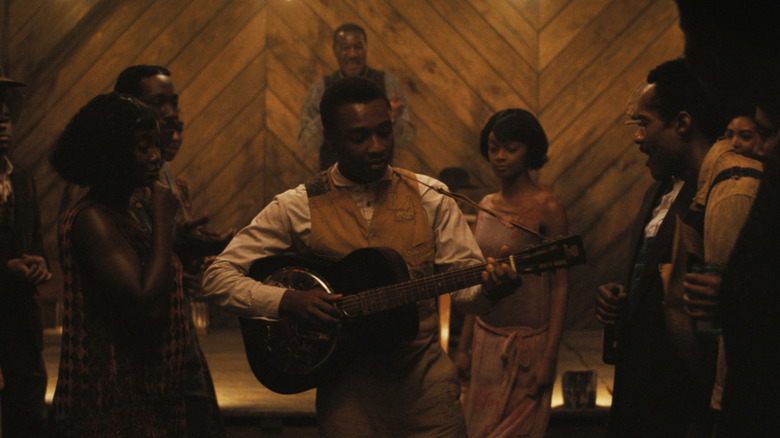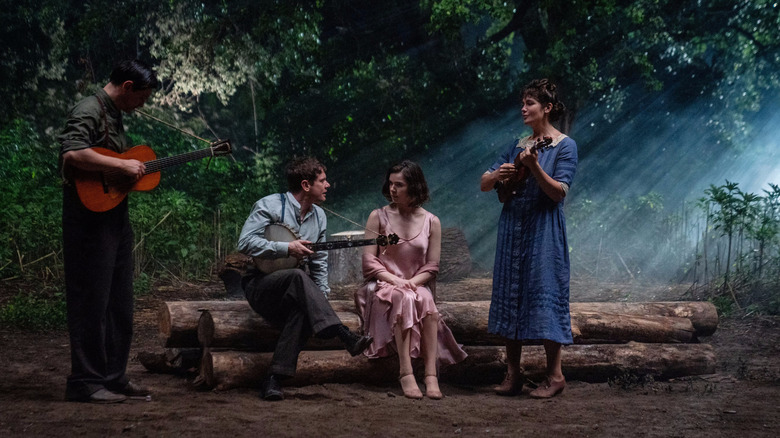Sinners' Big Musical Number Is 2025's Greatest Movie Scene (So Far)
This article contains spoilers for "Sinners."
Every great film contains a setpiece or a scene that doubles as a calling card for the movie as a whole. These moments are superlative because they involve every unique aspect of the film coming together perfectly, so much so that one could almost see just the scene by itself and know how and why the movie was so special. Yet these scenes have such power that, despite acting as a summation of the film, they only make one more eager to see the rest. All of this is to say that, even though we're only in April, we've got a movie that contains the greatest scene of the year: Ryan Coogler's "Sinners."
As I said, just about every great movie has a signature scene, but it's far rarer to see a scene in a film that not only stands out but is singularly transcendent as well. Sometimes these moments are incidental — the sort of "lightning in a bottle" magic that can be captured on set with the right people. In the case of "Sinners," its signature scene's power is absolutely constructed and choreographed by Coogler to be the film's centerpiece. (Although I haven't time-coded it, the scene may actually occur at the movie's midpoint.) In "Sinners," the plot revolves around the opening night of a juke joint in the Mississippi Delta of the 1930s, at which a young blues musician, Sammie Moore aka Preacherboy (Miles Caton), will be playing his music publicly for the first time. The occasion results in a massive musical number, one which acts as the heart of both the story and the movie itself. In essence, the musical number is a scene that is equally relevant to the film's plot, character, and theme — it is a scene which is, as they say, firing on all cylinders. Or, to put it another way, it really makes the film sing, literally and figuratively.
Preacherboy pierces the veil of time in Sinners
"Sinners" is many things, and one of them is a horror film involving vampires that has its own unique mythology. The movie opens with a brief infodump about this mythology, stating that throughout history there have been human beings (and particularly musicians) whose artistic prowess has been so powerful that their work can pierce the veil of time and space, bringing together the ancestors and descendants of the people around them in shared harmony and community. Essentially, this is a fantasy fiction literalization of the way music and art actually work in the real world, which is to be resonant enough that it makes one simultaneously feel timeless and strongly connected to the flow of time. Even for a period drama-cum-horror movie, it's ambitious, as Coogler makes the MacGuffin of his movie nothing less than the Power of Art.
Such a choice could backfire if not handled properly — after all, fans of M. Night Shyamalan are still debating whether his similarly pointed fantasy metaphors in "Lady in the Water" are illuminating or debilitating to that movie. Fortunately, Coogler puts all his considerable filmmaking prowess into selling this idea, and uses this centerpiece musical number scene to do it. After Delta Slim (Delroy Lindo) introduces Preacherboy Sammie to the packed juke joint crowd, Sammie launches into an original song of his, which he explains that he wrote for his pastor father. The personal, heartfelt, impassioned music lights up the joint and then some, inspiring everyone present to dance to it.
As Coogler and cinematographer Autumn Durald Arkapaw's camera glides around the entire space, we see that Sammie has indeed pierced the veil, causing the musical ancestors and descendants of the primarily Black crowd to appear in the space. This means that everything from African tribal musicians to electric guitar players to old-school hip hop MCs to modern-day DJs is both enjoying and contributing to the performance. The presence of some Chinese-American friends of the owners means that some of their brethren are present, too, with some Xiqu performers milling about. As the performance escalates further, the old sawmill that the juke's been built inside appears to burn away, something which presages the near future but also indicates how the music is transporting the people inside the building into another space, one of shared cultural harmony, literally and figuratively. It is an amazing scene that perfectly encapsulates the vast power of art itself.
Attack of the cultural appropriation vampires
The perfect button on the jaw-dropping scene comes when it's revealed that the revelers in the juke joint — and Sammie's music in particular — have attracted the attention of some nomadic vampires, led by Remmick (Jack O'Connell). As the opening prologue of the film stated, these vampires aren't merely after blood, but they also wish to consume and appropriate such transcendent art, literally and figuratively. As Remmick confesses to Sammie later, he needs to absorb the musicians' power in order to use it to contact his own long-dead ancestors and loved ones; due to his immortal nature, he's unspeakably lonely. While the portrayal of a vampire as a primarily lonely figure is nothing new in the creature's mythos, what is intriguingly fresh about Coogler's conception of the creature is how the vampires aren't misunderstood or secretly moral. These are some of the most compellingly nuanced vampires seen in any horror film, and Coogler is careful not to rigidly define them to make their seductiveness that much more powerful.
To wit, this isn't a riff on "Invasion of the Body Snatchers," where an encroaching force seeks to subsume and quell all instances of humanity. Later in the film, Coogler offers up a companion musical number to Sammie's performance, a scene in which the vampire horde performs their own music and dance to it with abandon. Although the scene is just as lively and just as infused with emotion as the earlier number, the key difference lies in the way the vampires operate. It's revealed that, despite each individual vampire insisting that they retain their human identity, they are all in thrall to the feelings of the vampire who made them, namely Remmick. Thus, the song they're happily dancing to is one from Remmick's past and upbringing, not their own. So, in this comparison, Coogler is showing us the difference between personal art, which primarily speaks to an individual (yet which can also be related to by myriad of other folks), and art which is deemed significant by an outside authority, whether that be a corporation, a cultural consensus, or otherwise.
As its title heavily suggests, "Sinners" is a film about people with imperfections, vampires or not. As in life, no one is wholly good, and no one is wholly bad, but all must constantly choose which path they're going to follow, and why. It is a piece of art which allows for genre escapism yet takes an honest look at a period in our country's past, and thus makes us question our own morals and motives. It is, in essence, a collective experience that stems from a personal inspiration, and Coogler brilliantly condenses that goal into the film's signature scene. Like any film, song, painting, or novel with rich layers, there's a lot for us to discover within it, both as a collective and as ourselves.
"Sinners" is now playing in theaters everywhere.


